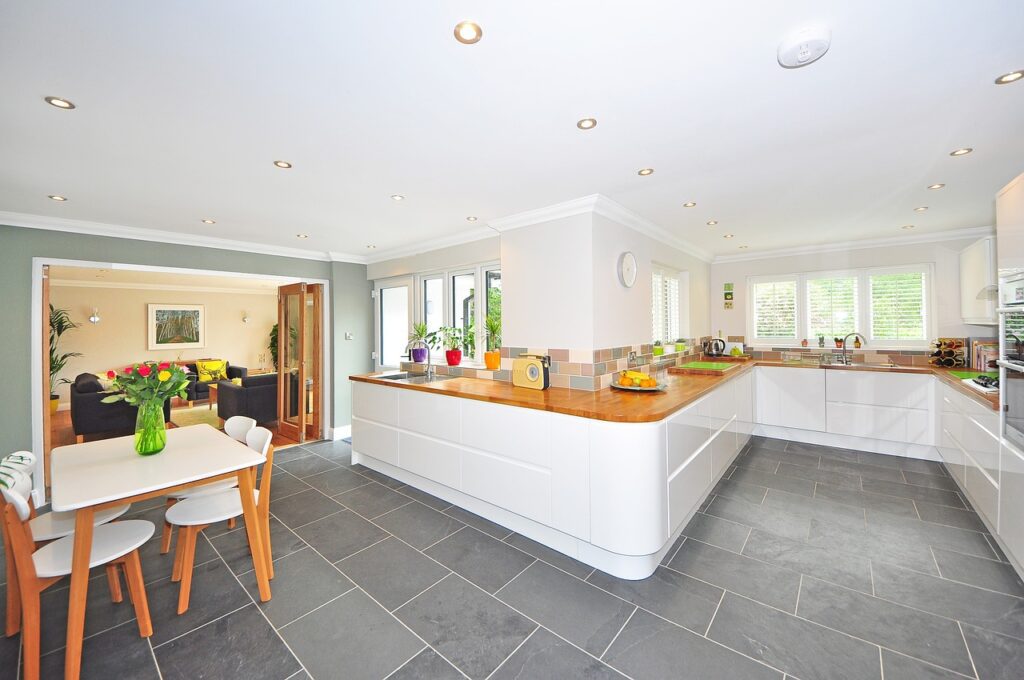Did you know that a well-thought-out floor plan can increase productivity by up to 20%? Creating a seamless layout isn’t just about aesthetics; it significantly influences how a space is utilized and perceived. By understanding the importance of flow in floor planning, you can transform your living or working environment into a harmonious and functional space that supports your lifestyle or business needs. In this post, we will explore practical tips on how to design a layout that enhances movement, maximizes space efficiency, and creates a sense of balance and coherence in any setting.
Understanding the Concept of Flow
Ease Movement
Flow in floor planning refers to the smooth movement and interaction within a space. It involves how one navigates through a room, ensuring that transitions are effortless and intuitive.
Creating a layout with excellent flow means designing spaces that allow individuals to move around comfortably without obstacles. This is crucial in areas such as the living room, kitchen, and hallways where frequent movement occurs.
Enhancing Comfort
A well-thought-out flow enhances the comfort and usability of a home. Imagine walking into a room where furniture is strategically placed, allowing for easy navigation without bumping into objects or feeling cramped.
When a layout considers flow, it contributes to a sense of spaciousness and openness. For instance, arranging furniture in a way that promotes traffic flow can make a room feel more inviting and functional.
Aesthetic and Functionality
The impact of flow extends beyond just movement; it significantly influences the overall aesthetic and functionality of a layout. A space with poor flow may appear cluttered and chaotic, detracting from its visual appeal.
On the other hand, when flow is prioritized during conceptualization, it results in a harmonious design where each element complements the other. This not only improves the visual aesthetics but also enhances the practicality of the space.
Mastering the Art of Reading Floor Plans
Key Symbols
When reading floor plans, understanding key symbols is crucial. Common symbols include circles for lights, lines for walls, and squares for furniture. Each symbol represents a specific element within the space, aiding in visualizing the layout accurately.
Dimension Interpretation
Interpreting dimensions on floor plans involves grasping the scale used. Typically, a scale ratio is provided to help translate measurements accurately. For instance, 1/4 inch might represent 1 foot in reality. Understanding this relationship ensures precise interpretation of room sizes and distances between elements.
Spatial Relationships
Spatial relationships on a floor plan depict how different areas interact with one another. By analyzing the placement of rooms, doors, and windows, one can discern traffic flow and functionality. Visualizing how spaces connect and influence each other is essential for creating a harmonious and functional layout.
Practice Makes Perfect
To enhance proficiency in reading floor plans, practice is key. Engaging with various floor plans, such as those for apartments, houses, or commercial spaces, allows individuals to familiarize themselves with different layouts and design conventions. This exposure builds confidence in deciphering floor plans accurately.
Grasping Scale and Proportion
Understanding Proportion
Understanding proportion is crucial in accurately visualizing room sizes and layouts. By grasping the relationship between different elements’ sizes, one can create a harmonious and well-balanced space. Visualizing how furniture and decor items will fit within a room requires a keen eye for precise measurements.
Enhancing Perceived Spaciousness
Proportions play a significant role in the perceived spaciousness of an area. By carefully considering the dimensions of each element within a space, you can create an illusion of more room. Strategic placement of furniture based on ratio and width can make a room feel larger or cozier, depending on the desired effect.
Utilizing Scale Models and Digital Tools
To better understand dimensions and proportions, utilizing scale models or digital tools can be immensely helpful. Physical scale models provide a tangible way to visualize how different elements will fit together in a space. Digital tools like floor planning software allow for precise adjustments to ensure optimal arrangement and flow within a room.
Benefits of Precise Measurements
- Ensures optimal use of space
- Helps in creating comfortable living environments
- Enhances the aesthetic appeal of a room by maintaining proper lines and views
Deciphering Room Layouts for Optimal Design
Room Shapes
Different room shapes play a crucial role in determining the furniture arrangement and overall flow of a space. For instance, in a large room, it’s essential to create distinct zones for various activities to avoid a cluttered look. Complex layouts may require strategic placement of furniture to ensure a harmonious design. Understanding the room dimensions is key to optimizing the available space efficiently.
Natural Light and Ventilation
The presence of natural light and adequate ventilation significantly impacts the decisions made in room layout. Placing furniture near windows can enhance the feeling of spaciousness and create a welcoming ambiance. Maximizing natural light not only brightens up the room but also contributes to energy efficiency. Proper ventilation ensures a healthy indoor environment, promoting comfort and well-being.
Space Utilization Strategies
To make the most of available space, consider incorporating design concepts that prioritize functionality without compromising aesthetics. Utilize common furniture symbols to experiment with various arrangements before finalizing the layout. Enrolling in an interior design course or seeking guidance from an interior design institute can provide valuable insights into creating tangible layouts that align with your design intentions. When planning spaces like bedrooms or a powder room, focus on selecting furniture that complements the room’s size and purpose.
Assessing Traffic Flow for Seamless Living
Primary Pathways
When designing a floor plan, it’s crucial to map out primary pathways that connect different areas of the house. These pathways should be clear and direct, allowing for easy navigation between rooms. By ensuring that these pathways are well-defined, you can create a seamless flow throughout the living space.
Identifying Bottlenecks
Identifying potential bottlenecks in traffic flow is essential for creating a functional layout. These bottlenecks can occur due to furniture placement, narrow hallways, or awkward room configurations. By pinpointing these areas, you can suggest adjustments to improve movement and prevent congestion in high-traffic areas.
Pros:
- Enhanced ease of movement
- Improved functionality of living space
Cons:
- Requires careful planning and consideration
- May involve rearranging existing furniture
Furniture Placement
Strategic furniture placement plays a significant role in facilitating unobstructed traffic flow within a home. Placing furniture in a way that allows for easy passage through rooms is key to creating a seamless layout. Consider the size and placement of each piece to ensure that it complements the overall flow of the space.
- Position larger furniture pieces against walls to open up central areas.
- Avoid blocking doorways or walkways with furniture arrangements.
- Use area rugs to define specific zones without obstructing traffic flow.

Interpreting Spatial Relationships
Enhancing Functionality
Adjacent spaces play a crucial role in spatial relationships, either improving or hindering functionality. When rooms flow seamlessly into one another, it enhances the overall usability of the space. For example, a living room that opens up to a dining area creates a sense of continuity, making both spaces feel more expansive and interconnected. On the other hand, abrupt transitions between rooms can disrupt the flow and make the space feel disjointed.
Proximity for Efficiency
Spatial organization thrives on the proximity of related areas. In floor planning, the distance between key spaces like kitchens and dining rooms significantly impacts daily activities. Placing these areas close together streamlines meal preparation and serving, promoting efficiency in everyday tasks. This strategic placement not only saves time but also encourages social interaction during meal times.
Fostering Interaction with Open-Concept Designs
Embracing spatial design principles like open-concept layouts can transform how spaces interact. By removing physical barriers, open layouts encourage movement and communication between different areas. For instance, an open kitchen flowing into a living room allows hosts to engage with guests while preparing meals. This design approach fosters a sense of togetherness and connectivity within the home.
Evaluating Functionality for Efficiency
Room Suitability
When evaluating functionality in floor planning, it is crucial to assess the suitability of room sizes and configurations. Rooms should be designed to facilitate daily activities seamlessly. For example, a spacious kitchen with easy access to cooking essentials enhances efficiency.
Consider how the size and layout of each room impact the occupants’ daily routines. A well-designed living room should provide ample space for relaxation and social gatherings. Functionality can be optimized by ensuring that furniture placement allows for easy movement and interaction within the space.
Storage Solutions and Organization
Efficient floor planning goes beyond aesthetics; it also considers the impact of layout on storage solutions and organization. Adequate storage spaces are essential for maintaining a clutter-free environment. Built-in cabinets, shelves, and closets maximize efficiency by keeping belongings organized and easily accessible.
Reviewing the placement of storage areas within each room is key to enhancing functionality. For instance, a bedroom layout that incorporates under-bed storage or a walk-in closet promotes organization and maximizes space utilization. By strategically incorporating storage solutions, the overall flow of the floor plan improves.
Specific Needs Accommodation
An essential aspect of evaluating functionality in floor planning is reviewing how well the design accommodates the specific needs of its occupants. Consideration should be given to factors such as mobility requirements, privacy preferences, and lifestyle habits. Customizing the layout to meet these needs enhances overall performance.
Creating designated areas within the floor plan that cater to specific activities can significantly improve efficiency. For example, a home office with adequate lighting and ergonomic furniture supports productivity. By tailoring the design to address individual requirements, the floor plan becomes more personalized and user-friendly.
Noting Architectural Features
Unique Elements
When considering architectural elements in floor planning, it’s crucial to identify unique features that can either enhance or hinder the flow within a space. Elements such as arches, columns, and built-ins play a significant role in shaping the overall layout and spatial dynamics of a room.
Impact on Spatial Dynamics
Arches provide a sense of openness and fluidity, creating a smooth transition between different areas within a space. On the other hand, columns can act as visual dividers, separating distinct zones while also adding structural support. Built-ins, like shelves or cabinets, not only optimize storage but also contribute to the overall aesthetic and functionality of a room.
Consideration in Layout Planning
When mapping out a floor plan, architects and designers must carefully consider these architectural features to ensure a seamless and cohesive layout. By strategically incorporating elements like arches to connect spaces or using columns to define specific areas, they can enhance the flow and functionality of the design. Integrating built-ins can help maximize space utilization while maintaining a harmonious balance between form and function.
Utilizing Technology and Tools
Software and Apps
When creating floor plans, utilizing tools like Floorplanner, RoomSketcher, or SketchUp can streamline the process. These applications offer user-friendly interfaces for designing layouts efficiently.
3D modeling software such as AutoCAD Architecture or Revit allows for a more in-depth understanding of spatial relationships within a space. This technology enables architects and designers to visualize how different elements interact in a room.
Virtual reality (VR) tools provide the ability to immerse oneself in a floor plan before any physical changes are made. By using VR headsets, individuals can walk through a space virtually, gaining a realistic sense of the layout’s flow.
Benefits of Technological Tools
The use of these tools significantly impacts the design process by enhancing visualization and precision. Designers can experiment with various layouts, furniture arrangements, and color schemes with ease.
By incorporating 3D modeling into floor planning, professionals and homeowners alike can better understand the components of a room. This technology aids in making informed decisions about spatial organization and aesthetics.
Virtual reality tools not only enhance the design process but also improve client communication. Clients can experience a proposed layout firsthand, making it easier for them to envision the final result.
Examples of Technological Integration
Tware like Floorplanner allows users to drag and drop furniture pieces onto a digital floor plan, simulating real-life movement within a space. This feature helps in determining the optimal furniture arrangement.
3D modeling software provides a detailed image source for architects to showcase their designs. By creating lifelike renderings, professionals can present their ideas more effectively to clients and stakeholders.
Virtual reality tools have revolutionized the way floor plans are presented. For instance, architects can showcase multiple design options to clients using VR, providing them with an immersive experience of each layout.
Summary
You’ve now grasped the essence of creating a seamless floor plan that prioritizes flow. By understanding spatial relationships, scale, and functionality, you’re equipped to design spaces that not only look great but also feel great to live in. Remember to leverage technology and tools to enhance your planning process further. Now, put your newfound knowledge into action and transform your living spaces into harmonious environments that cater to both aesthetics and practicality.
Design Your Perfect Floor Plan with Red White & Blue Construction!
Thinking about redesigning your floor plan? Your search ends here! Embark on an exciting journey to transform your Lafayette, CA home into the living space you’ve always dreamed of. With Red White & Blue Construction, every inch of your floor plan becomes a harmonious blend of beauty and functionality. Imagine innovative layouts that maximize your space’s potential, creating a natural flow that enhances both comfort and style. Whether you’re looking to optimize your current floor plan or dreaming up something entirely new, we’re here to bring your vision to life.
Our stellar reputation across the Bay Area speaks to our unwavering commitment to excellence, precision, and the highest standards of craftsmanship. We’re not just licensed contractors; we’re the creative minds behind your ideal living space. With transparent pricing and a client-first approach, you’re not just planning a floor—you’re laying the foundation for a whole new lifestyle. Choose Red White & Blue Construction and turn your home into a masterpiece. Design Your Perfect Floor Plan and connect with us today!
Disclaimer
The materials available on this website are for informational and entertainment purposes only and not to provide advice. You should obtain advice concerning any particular issue or problem from a professional. You should not act or refrain from acting based on any content included in this site without seeking legal or other professional advice. The information presented on this website may not reflect the most current building developments. No action should be taken in reliance on the information on this website. We disclaim all liability concerning actions taken or not taken based on any or all of the contents of this site to the fullest extent permitted by law.





